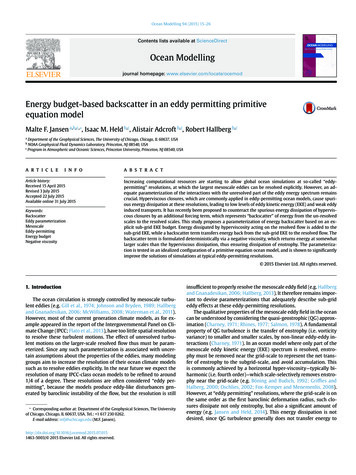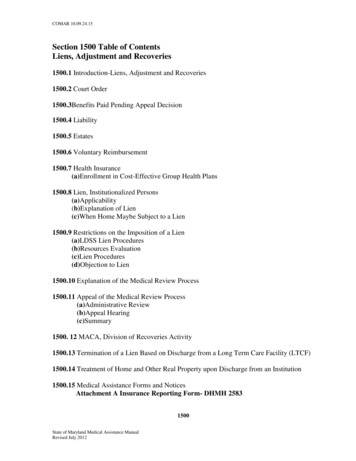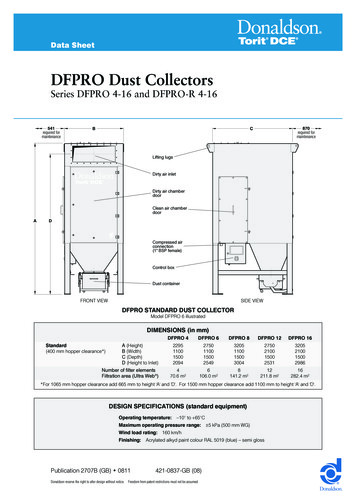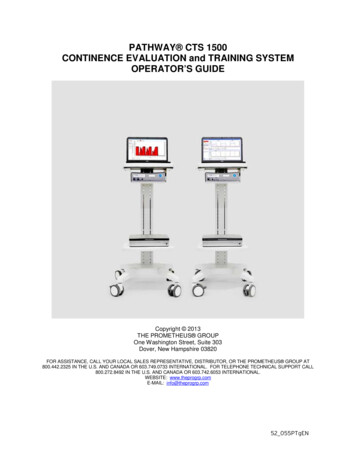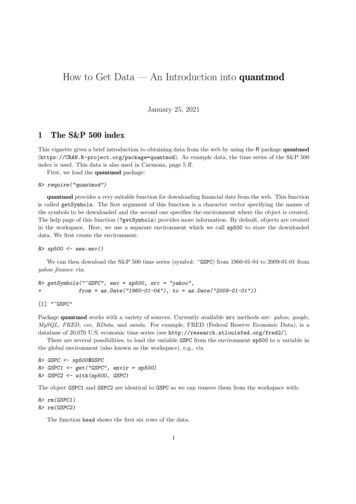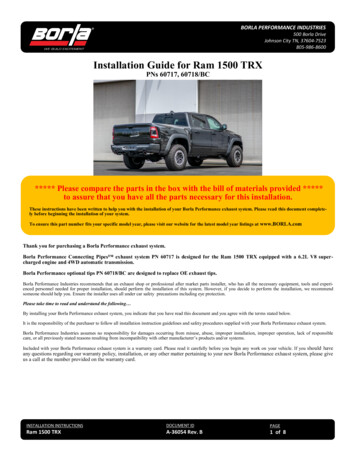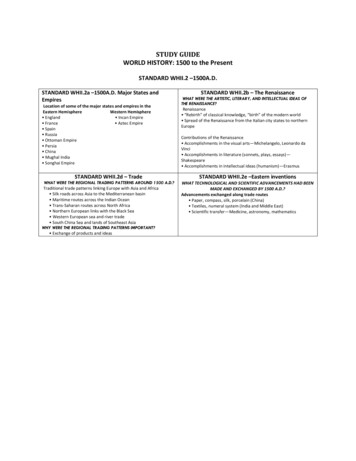
Transcription
STUDY GUIDEWORLD HISTORY: 1500 to the PresentSTANDARD WHII.2 –1500A.D.STANDARD WHII.2a –1500A.D. Major States andEmpiresLocation of some of the major states and empires in theEastern HemisphereWestern Hemisphere England Incan Empire France Aztec Empire Spain Russia Ottoman Empire Persia China Mughal India Songhai EmpireSTANDARD WHII.2b – The RenaissanceWHAT WERE THE ARTISTIC, LITERARY, AND INTELLECTUAL IDEAS OFTHE RENAISSANCE?Renaissance “Rebirth” of classical knowledge, “birth” of the modern world Spread of the Renaissance from the Italian city states to northernEuropeContributions of the Renaissance Accomplishments in the visual arts—Michelangelo, Leonardo daVinci Accomplishments in literature (sonnets, plays, essays)—Shakespeare Accomplishments in intellectual ideas (humanism)—ErasmusSTANDARD WHII.2d – TradeSTANDARD WHII.2e –Eastern inventionsWHAT WERE THE REGIONAL TRADING PATTERNS AROUND 1500 A.D.?Traditional trade patterns linking Europe with Asia and Africa Silk roads across Asia to the Mediterranean basin Maritime routes across the Indian Ocean Trans-Saharan routes across North Africa Northern European links with the Black Sea Western European sea and river trade South China Sea and lands of Southeast AsiaWHY WERE THE REGIONAL TRADING PATTERNS IMPORTANT? Exchange of products and ideasWHAT TECHNOLOGICAL AND SCIENTIFIC ADVANCEMENTS HAD BEENMADE AND EXCHANGED BY 1500 A.D.?Advancements exchanged along trade routes Paper, compass, silk, porcelain (China) Textiles, numeral system (India and Middle East) Scientific transfer—Medicine, astronomy, mathematics
STANDARD WHII.3 – REFORMATIONSTANDARD WHII.3a- Reform ideasSTANDARD WHII.3b – Impact of ReformationWHAT WERE THE PROBLEMS AND ISSUES THAT PROVOKEDRELIGIOUS REFORMS IN WESTERN CHRISTIANITY?Conflicts that challenged the authority of the Church in Rome Merchant wealth challenged the Church’s view of usury. German and English nobility disliked Italian domination of theChurch. The Church’s great political power and wealth caused conflict. Church corruption and the sale of indulgences were widespreadand caused conflict.WHAT WERE THE BELIEFS OF MARTIN LUTHER, JOHN CALVIN, HENRYVIII AND ELIZABETH I?Martin Luther (the Lutheran tradition) Views—Salvation by faith alone, Bible as the ultimate authority, allhumans equal before God Actions—95 theses, birth of the Protestant Church John Calvin (the Calvinist tradition) Views—Predestination, faith revealed by living a righteous life,work ethic Actions—Expansion of the Protestant MovementKing Henry VIII Views—Dismissed the authority of the Pope in Rome Actions—Divorced; broke with Rome; headed the national church inEngland; appropriated lands and wealth of the Roman CatholicChurch in EnglandQueen Elizabeth I Anglican Church Tolerance for dissenters Expansion and colonialism Victory over the Spanish Armada (1588)WHAT WERE THE MAJOR ECONOMIC, POLITICAL, AND THEOLOGICALISSUES INVOLVED IN THE REFORMATION?Reformation in Germany Princes in Northern Germany converted to Protestantism, endingauthority of the Pope in their states. The Hapsburg family and the authority of the Holy Roman Empirecontinued to support the Roman Catholic Church. Conflict between Protestants and Catholics resulted in devastatingwars (e.g., Thirty Years’ War).Reformation in France Catholic monarchy granted Protestant Huguenots freedom ofworship by the Edict of Nantes (later revoked). Cardinal Richelieu changed the focus of the Thirty Years’ War from areligious to a political conflict.Catholic Reformation Dissenters prior to Luther - Huss, Wycliffe Counter Reformation The Council of Trent reaffirmed most Church doctrine and practice. The Society of Jesus (The Jesuits) was founded to spread Catholicdoctrine around the world. The Inquisition was used to reinforce Catholic doctrine.STANDARD WHII.3c – Changing valuesNotes: ReformationWHAT WERE SOME OF THE CHANGING CULTURAL VALUES,TRADITIONS, AND PHILOSOPHIES DURING THEREFORMATION?Changing cultural values, traditions, and philosophies Growth of secularism Growth of individualism Eventual growth of religious toleranceWHAT WAS THE ROLE OF THE PRINTING PRESS IN THE SPREAD OFNEW IDEAS? Growth of literacy was stimulated by the Gutenberg printingpress. The Bible was printed in English, French, and German. These factors had an important impact on spreading the ideas ofthe Reformation and Renaissance.
STANDARD WHII.4 -- Age of DiscoverySTANDARD WHII.4a – Motivation for explorationWHY WERE EUROPEANS INTERESTED IN DISCOVERING NEWLANDS AND MARKETS?Factors contributing to the European discovery of lands in theWestern Hemisphere Demand for gold, spices, and natural resources in Europe Support for the diffusion of Christianity Political and economic competition between European empires Innovations in navigational arts (European and Islamic origins) Pioneering role of Prince Henry the NavigatorSTANDARD WHII.4b – Influence of ReligionHOW DID THE EXPANSION OF EUROPEAN EMPIRES INTO THEAMERICAS, AFRICA, AND ASIA AFFECT THE RELIGION INTHOSE AREAS?Means of diffusion of Christianity Migration of colonists to new lands Influence of Catholics and Protestants, who carried their faith,language, and cultures to new lands Conversion of indigenous peoplesWHO WERE SOME IMPORTANT EXPLORERS? Portugal—Vasco da Gama Spain—Christopher Columbus, Hernando Cortez, FranciscoPizarro, Ferdinand Magellan England—Francis Drake France—Jacques CartierSTANDARD WHII.4c – Settlement PatternsWHAT WAS THE EFFECT OF EUROPEAN MIGRATION ANDSETTLEMENT ON THE AMERICAS, AFRICA, AND ASIA?Americas Expansion of overseas territorial claims and European emigrationto North and South America Demise of Aztec and Inca Empires Legacy of a rigid class system and dictatorial rule in Latin America Forced migration of some Africans into slavery Colonies’ imitation of the culture and social patterns of theirparent countryAfrica European trading posts along the coast Trade in slaves, gold, and other productsAsia Colonization by small groups of merchants (India, the Indies,China) Influence of trading companies (Portuguese, Dutch, British)STANDARD WHII.4e, f--Triangular TradeWHAT WAS THE TRIANGULAR TRADE?The triangular trade linked Europe, Africa, and the Americas. Slaves,sugar, and rum were traded.WHAT WAS THE IMPACT OF PRECIOUS METAL EXPORTSFROM THE AMERICAS? Gold and silver (exported to Europe and Asia) Impact on indigenous empires of the Americas Impact on Spain and international tradeSTANDARD WHII.4d—Columbian ExchangeWHAT WAS THE IMPACT OF THE COLUMBIAN EXCHANGEBETWEEN EUROPEAN AND INDIGENOUS CULTURES?Columbian Exchange Western Hemisphere agricultural products such as corn, potatoes,and tobacco changed European lifestyles. European horses and cattle changed the lifestyles of AmericanIndians European diseases like smallpox killed many American IndiansImpact of the Columbian Exchange Shortage of labor to grow cash crops led to the use of Africanslaves. Slavery was based on race. European plantation system in the Caribbean and the Americasdestroyed indigenous economics and damaged the environment.Notes: Age of Discovery
STANDARD WHII.5 -- Global Trade after 1500ADSTANDARD WHII.5a –Ottoman EmpireSTANDARD WHII.5b – IndiaWHERE WAS THE OTTOMAN EMPIRE LOCATED AND HOWDID IT EXPAND?WHAT WERE THE CONTRIBUTIONS OF THE MUGHALEMPERORS OF INDIA?Original location of the Ottoman Empire Asia MinorExpansion and extent of the Ottoman Empire Southwest Asia Southeastern Europe, Balkan Peninsula North AfricaDevelopment of the Ottoman Empire Capital at Constantinople renamed Istanbul Islamic religion as a unifying force that accepted otherreligions Trade in coffee and ceramicsLocation of the Mughal Empire North IndiaContributions of Mughal rulers Spread of Islam into India Art and architecture—Taj Mahal Arrival of European trading outposts Influence of Indian textiles on British textile industrySTANDARD WHII.5c – East AsiaHOW DID THE CHINESE AND JAPANESE ATTEMPT TO LIMITTHE INFLUENCE OF EUROPEAN MERCHANTS?China Creation of foreign enclaves to control trade Imperial policy of controlling foreign influences and trade Increase in European demand for Chinese goods (tea, porcelain)Japan Characterized by powerless emperor controlled by militaryleader (shogun) Adopted policy of isolation to limit foreign influencesSTANDARD WHII.5e—European growthWHAT WERE THE ROLES OF THE COMMERCIAL REVOLUTIONAND MERCANTILISM IN THE GROWTH OF EUROPEANNATIONS?Mercantilism:An economic practice adopted by Europeancolonial powers in an effort to become self-sufficient; based onthe theory that colonies existed for the benefit of the mothercountryCommercial Revolution European maritime nations competed for overseas markets,colonies, and resources. A new economic system emerged.– New money and banking systems were created.– Economic practices such as mercantilism evolved.– Colonial economies were limited by the economic needs ofthe mother countryHOW DID THE MUGHAL EMPIRE TRADE WITH EUROPEANNATIONS? Portugal, England, and the Netherlands competed for the IndianOcean trade by establishing Coastal ports on the Indian subcontinent.WHAT DID SOUTHERN INDIA TRADE?Southern India traded silks, spices, and gemsSTANDARD WHII.5d—AfricaHOW DID AFRICA BECOME INVOLVED IN FOREIGN TRADE?African exports Slaves (triangular trade) Raw materialsAfrican imports Manufactured goods from Europe, Asia, and the Americas New food products (corn, peanuts)Notes: Global Trade after 1500AD
STANDARD WHII.6 -- 16th-18th CenturiesSTANDARD WHII.6a—Scientific RevolutionWHAT WERE SOME NEW SCIENTIFIC THEORIES ANDDISCOVERIES?Pioneers of the scientific revolution Nicolaus Copernicus: Developed heliocentric theory Johannes Kepler: Discovered planetary motion Galileo Galilei: Used telescope to support heliocentric theory Isaac Newton: Discovered Laws of Gravity William Harvey: Discovered circulation of the bloodWHAT WERE SOME OF THE EFFECTS OF THESE NEWTHEORIES?STANDARD WHII.6b – Age of AbsolutismCharacteristics of absolute monarchies Centralization of power Concept of rule by divine rightWHO WERE THE ABSOLUTE MONARCHS?Absolute monarchs Louis XIV—France, Palace of Versailles as a symbol of royalpower Peter the Great—Russia, westernization of RussiaImportance of the scientific revolution Emphasis on reason and systematic observation of nature Formulation of the scientific method Expansion of scientific knowledgeSTANDARD WHII.6c—Glorious RevolutionHOW DID THE ENGLISH CIVIL WAR AND THE GLORIOUSREVOLUTION PROMOTE THE DEVELOPMENT OF THE RIGHTSOF ENGLISHMEN?Development of the rights of Englishmen Oliver Cromwell and the execution of Charles I The restoration of Charles II Development of political parties/factions Glorious Revolution (William and Mary) Increase of parliamentary power over royal power English Bill of Rights of 1689STANDARD WHII.6d – EnlightenmentHOW DID PHILOSOPHERS OF THE ENLIGHTENMENTINFLUENCE THINKING ON POLITICAL ISSUES?The Enlightenment Applied reason to the human world, not just the natural world Stimulated religious tolerance Fueled democratic revolutions around the worldWHO WERE SOME ENLIGHTENMENT THINKERS, ANDWHAT WERE THEIR IDEAS?Enlightenment thinkers and their ideas Thomas Hobbes’ Leviathan: Humans exist in a primitive “state ofnature” and consent to government for self-protection. John Locke’s Two Treatises on Government: People are sovereignand consent to government for protection of natural rights to life,liberty, and property. Montesquieu’s The Spirit of Laws: The best form of governmentincludes a separation of powers. Jean-Jacques Rousseau’s The Social Contract—Government is acontract between rulers and the people. Voltaire—Religious toleration should triumph over religiousfanaticism; separation of church and stateHOW DID THE ENLIGHTENMENT PROMOTE REVOLUTIONIN THE AMERICAN COLONIES?Influence of the Enlightenment Political philosophies of the Enlightenment fueled revolution in theAmericas and France. Thomas Jefferson’s Declaration of Independence incorporatedEnlightenment ideas. The Constitution of the United States of America and Bill of Rightsincorporated Enlightenment ideas.STANDARD WHII.6e – French RevolutionSTANDARD WHII.6f -- Arts. Philosophy, LiteratureHOW DID THE IDEAS OF THE ENLIGHTENMENTCONTRIBUTE TO CAUSING THE FRENCH REVOLUTION?WHO WERE SOME ARTISTS, PHILOSOPHERS, ANDWRITERS OF THE PERIOD?Causes of the French Revolution Influence of Enlightenment ideas Influence of the American RevolutionEvents of the French Revolution Storming of the Bastille Reign of TerrorOutcomes of the French Revolution End of the absolute monarchy of Louis XVI Rise of NapoleonRepresentative artists, philosophers, and writers Johann Sebastian Bach: Baroque composer Wolfgang Amadeus Mozart: Classical composer Voltaire: Philosopher Miguel de Cervantes: Novelist Eugène Delacroix: Painter (transition to the Romantic School ofthe nineteenth century)New schools of art and forms of literature Paintings depicted classical subjects, public events, naturalscenes, and living people (portraits). New forms of literature—the novel (Cervantes’ Don Quixote).
Standard WH II.7 – Latin American RevolutionsStandard WH II.7a - Colonial SystemSTANDARD WHII.7b—Revolutions in Latin AmericaWHAT WERE THE CHARACTERISTICS OF THE COLONIALSYSTEM IN LATIN AMERICA IN THE NINETEENTH CENTURY? Colonial governments mirrored the home governments. Catholicism had a strong influence on the development ofthe colonies. A major element of the economy was the mining of preciousmetals for export.HOW DID SPAIN AND PORTUGAL MAINTAIN CONTROL OFTHEIR LATIN AMERICAN DOMAINS?Rigid class structure Viceroys / colonial officers Creoles MestizosHOW DID THE AMERICAN AND FRENCH REVOLUTIONSINFLUENCE LATIN AMERICAN INDEPENDENCE MOVEMENTS? Slaves in Haiti rebelled, abolished slavery, and wonindependence. Father Miguel Hidalgo started the Mexican independencemovement. French, Spanish, and Portuguese colonies gainedindependence.Selected countries that gained independence during the1800s Mexico Haiti Colombia Venezuela BrazilSTANDARD WHII.7c --L’Ouverture and BolivarWHAT WERE THE CONTRIBUTIONS OF TOUSSAINTL’OUVERTURE AND SIMÓN BOLIVAR TO REVOLUTIONSIN LATIN AMERICA?Contributions of Toussaint L’Ouverture Former slave who led Haitian rebellion against French Defeated the armies of three foreign powers: Spain, France,and BritainContributions of Simón Bolivar Native resident who led revolutionary efforts Liberated the northern areas of Latin AmericaSTANDARD WHII.7d –Monroe DoctrineHOW DID THE MONROE DOCTRINE IMPACTREVOLUTIONS IN LATIN AMERICA?Impact of the Monroe Doctrine The Monroe Doctrine was issued by President JamesMonroe in 1823. Latin American nations were acknowledged to beindependent. The United States would regard as a threat to its own peaceand safety any attempt by European powers to impose theirsystem on any independent state in the Western Hemisphere.
Standard WH II.8 – Political and Philosophical Developments in EuropeSTANDARD WHII.8a -- NapoleonWHAT WAS THE LEGACY OF NAPOLEON? Unsuccessful attempt to unify Europe under Frenchdomination Napoleonic Code Awakened feelings of national pride and growth ofnationalismWHAT WAS THE SIGNIFICANCE OF THE CONGRESS OFVIENNA? “Balance of power” doctrine Restoration of monarchies New political map of Europe New political philosophies (liberalism, conservatism)STANDARD WHII.8c – ItalyWHAT EVENTS LED TO THE UNIFICATION OF ITALY?Unification of Italy Count Cavour unified Northern Italy. Giuseppe Garibaldi joined southern Italy to northern Italy. The Papal States (including Rome) became the last to joinItaly.STANDARD WHII.8b – Great BritainHOW DID NATIONALISM AND DEMOCRACY INFLUENCENATIONAL REVOLUTIONS?National pride, economic competition, and democratic idealsstimulated the growth of nationalism.The terms of the Congress of Vienna led to widespreaddiscontent in Europe. especially in Italy and the Germanstates. Unsuccessful revolutions of 1848 increasednationalistic tensions.In contrast to continental Europe, Great Britain expandedpolitical rights through legislative means and made slaveryillegal in the British Empire.STANDARD WHII.8 d – GermanyWHAT ROLE DID OTTO VON BISMARCK PLAY IN THEUNIFICATION OF GERMANY?Unification of Germany Otto von Bismarck led Prussia in the unification of Germanythrough war and by appealing to nationalist feelings. Bismarck’s actions were seen as an example of Realpolitik,which justifies all means to achieve and hold power. The Franco-Prussian War led to the creation of the Germanstate.
STANDARD WHII.9a – Industrial RevolutionSTANDARD WHII.9a -- Industrial RevolutionSTANDARD WHII.9b – Capitalism, CommunismWHY DID THE INDUSTRIAL REVOLUTION ORIGINATE INENGLAND? Origin in England, because of its natural resources like coal,iron ore, and the invention and improvement of the steamengine Spread to Europe and the United States Role of cotton textile, iron, and steel industries Relationship to the British Enclosure Movement Rise of the factory system and demise of cottage industriesTechnological advances that produced the IndustrialRevolution Spinning jenny: James Hargreaves James Watt—Steam engine Eli Whitney—Cotton gin Henry Bessemer—Process for making steelAdvancements in science and medicine Edward Jenner—Developed smallpox vaccination Louis Pasteur—Discovered bacteriaImpacts of the Industrial Revolution on industrializedcountries Population increase Increased standards of living for many, though not all Improved transportation Urbanization Environmental pollution Increased education Dissatisfaction of working class with working conditions Growth of the middle classWHAT WAS THE ROLE OF CAPITALISM AND MARKETCOMPETITION IN THE INDUSTRIAL REVOLUTION?Capitalism Adam Smith’s Wealth of Nations Role of market competition and entrepreneurial abilities Impact on standard of living and the growth of the middleclass Dissatisfaction with poor working conditions and theunequal distribution of wealth in societyWHAT WERE SOME THEORIES OPPOSED TO CAPITALISM?Socialism and communism Karl Marx’s Communist Manifesto (written with FriedrichEngels) and Das Capital Response to the injustices of capitalism Importance of redistribution of wealth to the communistsWHY DID WORKERS ORGANIZE INTO LABOR UNIONS?The rise of labor unions Encouraged worker-organized strikes to increase wages andimprove working conditions Lobbied for laws to improve the lives of workers, includingwomen and children Wanted worker rights and collective bargaining betweenlabor and managementSTANDARD WHII.9c – Impact on SocietySTANDARD WHII.9d ImperialismHOW DID THE INDUSTRIAL REVOLUTION IMPACT THE LIVESOF WOMEN, CHILDREN, AND THE FAMILY?The nature of work in the factory system Family-based cottage industries displaced by the factorysystem Harsh working conditions with men competing with womenand children for wages Child labor that kept costs of production low and profitshigh Owners of mines and factories who exercised considerablecontrol over the lives of their laborersHOW DID THE INDUSTRIAL REVOLUTION AFFECT SLAVERY?Impact of the Industrial Revolution on slavery The cotton gin increased demand for slave labor onAmerican plantations. The United States and Britain outlawed the slave trade andthen slavery.Social effects of the Industrial Revolution Women and children entering the workplace as cheap labor Introduction of reforms to end child labor Expansion of education Women’s increased demands for suffrageWHY DID EUROPEAN COUNTRIES PARTICIPATE INIMPERIALISM AND A RACE FOR COLONIES?Imperialism in Africa and Asia European domination European conflicts carried to the colonies Christian missionary efforts Spheres of influence in China Suez Canal East India Company’s domination of Indian states American opening of Japan to tradeOutcomes and global effects Colonies’ participation in the war, which increased demandsfor independence End of the Russian Imperial, Ottoman, German, and AustroHungarian empires Enormous cost of the war in lives, property, and socialdisruptionResponses of colonized peoples Armed conflicts (Events leading to the Boxer Rebellion inChina) Rise of nationalism (first Indian nationalist party founded inthe mid-1800s)
WHII.10 World War ISTANDARD WHII.10a—Causes of World War IWHAT WERE THE FACTORS THAT PRODUCED WORLDWAR I?Causes of World War I Alliances that divided Europe into competing camps Nationalistic feelings Diplomatic failures Imperialism Competition over colonies MilitarismWHAT WERE THE OUTCOMES AND GLOBAL EFFECTS OFWORLD WAR I?Outcomes and global effects Colonies’ participation in the war, which increased demandsfor independence End of the Russian Imperial, Ottoman, German, and AustroHungarian empires Enormous cost of the war in lives, property, and socialdisruptionWHAT WERE THE TERMS OF THE TREATY OF VERSAILLES? Forced Germany to accept guilt for war and loss of territoryand pay reparations Limited the German military League of NationsSTANDARD WHII.10b—Events & Leader ofWorld War IWHAT WERE THE MAJOR EVENTS OF THE WAR?Major events Assassination of Austria’s Archduke Ferdinand United States enters war Russia leaves the warWHO WERE THE MAJOR LEADERS?Major leaders Woodrow Wilson Kaiser Wilhelm IISTANDARD WHII.10c-- Russian RevolutionWHY DID RUSSIA ERUPT IN REVOLUTION WHILE FIGHTING INWORLD WAR I?Causes of 1917 revolutions Defeat in war with Japan in 1905 Landless peasantry Incompetence of Tsar Nicholas II Military defeats and high casualties in World War IHOW DID COMMUNISM RISE IN RUSSIA?Rise of communism Bolshevik Revolution and civil war Vladimir Lenin’s New Economic Policy Lenin’s successor—Joseph Stalin
WH.11-- The Interwar PeriodSTANDARD WHII.11a – League of NationsSTANDARD WHII.11b – DepressionWHAT WAS THE LEAGUE OF NATIONS AND WHY DID IT FAIL? International cooperative organization Established to prevent future wars United States not a member Failure of League because it did not have power to enforceits decisionsWHY WAS THE MANDATE SYSTEM CREATED? During World War I, Great Britain and France agreed todivide large portions of the Ottoman Empire in the MiddleEast between themselves. After the war, the “mandate system” gave Great Britain andFrance control over the lands that became Iraq, Transjordan,and Palestine (British controlled) and Syria and Lebanon(French controlled).WHY DID THE WORLD EXPERIENCE DEPRESSION IN THE1930S?Causes of worldwide depression German reparations Expansion of production capacities and dominance of theUnited States in the global economy High protective tariffs Excessive expansion of credit Stock Market Crash (1929)WHAT POLITICAL CHANGES RESULTED FROM THEWORLDWIDE DEPRESSION?Impact of world depression High unemployment in industrial countries Bank failures and collapse of credit Collapse of prices in world trade Nazi Party’s growing importance in Germany; Nazi Party’sblame of European Jews for economic collapseSTANDARD WHII.11c – DictatorsWHY DID DICTATORIAL GOVERNMENTS EMERGE INGERMANY, ITALY, JAPAN, AND THE U.S.S.R. AFTER WORLDWAR I?U.S.S.R. during the Interwar Period—Joseph Stalin Entrenchment of communism Stalin’s policies (five-year plans, collectivization of farms,state industrialization, secret police) Great PurgeGermany during the Interwar Period—Adolf Hitler Inflation and depression Democratic government weakened Anti-Semitism Extreme nationalism National Socialism (Nazism) German occupation of nearby countriesItaly during the Interwar Period—Benito Mussolini Rise of fascism Ambition to restore the glory of Rome Invasion of EthiopiaJapan during the Interwar Period—Hirohito and Hideki Tojo Militarism Industrialization of Japan, leading to drive for raw materials Invasion of Korea, Manchuria, and the rest of China
WH11.12 World War IISTANDARD WHII.12a- CausesWHAT WERE THE CAUSES OF WORLD WAR II?Economic and political causes of World War II Aggression by totalitarian powers (Germany, Italy, Japan) Nationalism Failures of the Treaty of Versailles Weakness of the League of Nations Appeasement Tendencies towards isolationism and pacifism in Europe andthe United StatesWHO WERE THE MAJOR LEADERS OF WORLD WAR II?Major leaders of the war Franklin D. Roosevelt—U.S. President Harry Truman—U.S. President after death of PresidentRoosevelt Dwight D. Eisenhower— Allied commander in Europe Douglas MacArthur—U.S. general George Marshall—U.S. general Winston Churchill—British prime minister Joseph Stalin—Soviet dictator Adolf Hitler—Nazi dictator of Germany Hideki Tojo—Japanese general Hirohito—Emperor of JapanSTANDARD WHII.12c – War CrimesWHAT WERE THE WAR CRIMES TRIALS?The Universal Declaration of Human Rights was issued in1948 to protect the “inherent dignity and the equal andinalienable rights of all members of the human family .”HOW DID THE ALLIES PROMOTE RECONSTRUCTION OFTHE DEFEATED POWERS?Efforts for reconstruction of Germany Democratic government installed in West Germany andWest Berlin Germany and Berlin divided among the four Allied powers Emergence of West Germany as economic power in postwarEuropeEfforts for reconstruction of Japan U.S. occupation of Japan under MacArthur’s administration Democracy and economic development Elimination of Japanese offensive military capabilities;United States’ guarantee of Japan’s security Emergence of Japan as dominant economy in AsiaSTANDARD WHII.12a- Major Leaders & EventsWHAT WERE THE MAJOR EVENTS OF WORLD WAR II?Major events of the war (1939-1945) German invasion of Poland Fall of France Battle of Britain German invasion of the Soviet Union Japanese attack on Pearl Harbor D-Day (Allied invasion of Europe) Atomic bombs dropped on Hiroshima and NagasakiSTANDARD WHII.12b—GenocideGenocide: The systematic and purposeful destruction of aracial, political, religious, or cultural groupWHY DID THE HOLOCAUST OCCUR? Totalitarianism combined with nationalism History of anti-Semitism Defeat in World War I and economic depression blamed onGerman Jews Hitler’s belief in the master race Final solution—Extermination camps, gas chambersExamples of other genocides Armenians by leaders of the Ottoman Empire Peasants, government and military leaders, and members ofthe elite in the Soviet Union by Joseph Stalin The educated, artists, technicians, former governmentofficials, monks, and minorities by Pol Pot in Cambodia Tutsi minority by Hutu in RwandaWHAT WERE THE OUTCOMES OF WORLD WAR II? European powers’ loss of empires Establishment of two major powers in the world: TheUnited States and the U.S.S.R. War crimes trials Division of Europe—Iron Curtain Establishment of the United Nations The Universal Declaration of Human Rights Marshall Plan Formation of North Atlantic Treaty Organization (NATO) andWarsaw PactWHAT WERE THE INTERNATIONAL COOPERATIVEORGANIZATIONS CREATED AFTER WORLD WAR II?International Cooperative Organizations United Nations North Atlantic Treaty Organization (NATO) Warsaw PactThe Universal Declaration of Human Rights Established and adopted by members of the United Nations Provided a code of conduct for the treatment of peopleunder the protection of their government
WH11.13 – 2nd half of 20th centurySTANDARD WHII.13a – Cold War EventsWHAT EVENTS LED TO THE COLD WAR?Beginning of the Cold War (1945-1948) The Yalta Conference and the Soviet control of EasternEurope Rivalry between the United States and the U.S.S.R. Democracy and the free enterprise system v. dictatorshipand communism President Truman and the Policy of Containment Eastern Europe—Soviet satellite nations; the Iron CurtainWHAT WERE THE CAUSES AND CONSEQUENCES OF THECOLLAPSE OF THE SOVIET UNION?Collapse of Communism in the Soviet Union and EasternEurope Soviet economic collapse Nationalism in Warsaw Pact countries Tearing down of Berlin Wall Breakup of the Soviet Union Expansion of NATOSTANDARD WHII.13d – World LeadersIndira Gandhi Closer relationship between India and the Soviet Unionduring the Cold War Developed nuclear programMargaret Thatcher British Prime Minister Free trade and less government regulation of business Close relationship with United States and U.S. foreign policy Asserted United Kingdom’s military powerMikhail Gorbachev Glasnost and perestroika Fall of the Berlin Wall Last president of Soviet Union Oversaw peaceful transition to democracyDeng Xiaoping Reformed communist economy to market economyleading to rapid economic growthSTANDARD WHII.13b – The Playing FieldWHAT WAS THE IMPACT OF NUCLEAR WEAPONS? North Atlantic Treaty Organization (NATO) v. the WarsawPact Korean Conflict Vietnam War Berlin and significance of Berlin Wall Cuban Missile Crisis Nuclear weapons and the theory of deterrenceSTANDARD WHII.13c – Asian ConflictsWHAT WAS THE POLICY OF CONTAINMENT?Policy for preventing the expansion of communismHOW DID THE COLD WAR INFLUENCE CONFLICTS INEASTERN ASIA AFTER WORLD WAR II? Conflicts and revolutionary movements in China Division of China into two nations at the end of the Chinesecivil war Chiang Kai-shek (Jiang Jieshi)—Nationalist China (island ofTaiwan) Mao Tse-tung (Mao Zedong)—Communist China (mainlandChina)Conflicts and revolutionary movements in Vietnam Role of French Imperialism Leadership of Ho Chi Minh Vietnam as a divided nation Influence of policy of containment The United States and the Vietnam War Vietnam as a reunited communist country today
WH11.14 Independence MovementsSTANDARD WHII.14a – IndiaSTANDARD WHII.14b – AfricaWHO WAS A LEADER OF THE INDIAN INDEPENDENCEMOVEMENT, AND WHAT TACTICS DID HE USE?Regional setting for the Indian independence movement Indian sub-continent British India India Pakistan (former West Pakistan) Bangladesh (former East Pakistan) Sri Lanka (former Ceylon)WHAT WERE THE OUTCOMES
WORLD HISTORY: 1500 to the Present STANDARD WHII.2 -1500A.D. STANDARD WHII.2a -1500A.D. Major States and Empires Location of some of the major states and empires in the Eastern Hemisphere Western Hemisphere England Incan Empire
